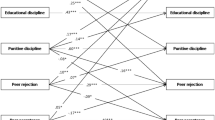Abstract
The purpose of this study was to examine the predictive validity of a teacher nomination procedure for identifying at- risk children. Two hundred and twenty-five children were nominated by their teachers as well- adjusted (n= 75), socially withdrawn (n=76), or socially aggressive (n=74) during the fourth grade. Five years later, 198 of these children (88%) were located and their adjustment evaluated. Significant differences among the nominated children were found on a variety of measures, including academic grades, sociometric status, and social behavior. In addition, differences in school dropout and delinquent offenses were noted. Results are discussed in terms of the validity of teacher nomination procedures and their utility in identifying at- risk youth.
Similar content being viewed by others
References
American Psychiatric Association (1987). Diagnostic and statistical manual of mental disorders (3rd ed., rev.). Washington, DC: Author.
Asher, S. R., & Dodge, K. A. (1986). Identifying children who are rejected by their peers.Developmental Psychology, 22, 444–449.
Bierman, K. L. (1986). The relation between social aggression and peer rejection in middle childhood. In R. J. Prinz (Ed.),Advances in behavioral assessment of children and families (Vol. 2, pp. 151–178). New York: JAI Press.
Bolstad, O. D., & Johnson, S. M. (1977). The relationship between teachers' assessment of students and students' actual behavior in the classroom.Child Development, 48, 570–578.
Coie, J. D., Dodge, K. A., & Copotelli, H. (1982). Dimensions and types of status: A cross-age perspective.Developmental Psychology, 18, 557–570.
Dodge, K. A. (1983). Behavioral antecedents of peer social status.Child Development, 54, 1386–1389.
Green, K. D., Beck, S. J., Forehand, R., & Vosk, B. (1980). Validity of teacher nominations of child behavior problems.Journal of Abnormal Child Psychology, 8, 397–404.
Hartup, W. W. (1989). Social relationships and their developmental significance.American Psychologist, 44, 120–126.
Hymel, S., & Rubin, K. H. (1985). Children with peer relationship and social skill problems: Conceptual, methodological, and developmental issues. In G. J. Whitehurst (Ed.),Annals of child development (Vol. 2, pp. 251–297). Greenwich, CT: JAI Press.
Johnson, D. W. (1980). Group processes: Influences of student-student interaction on school outcomes. In J. H. McMillan (Ed.),Social psychology of school learning (pp. 123–168). New York: Academic Press.
Langlois, J. H., & Stephan, C. W. (1981). Beauty and the beast: The role of physical attractiveness in the development of peer relations and social behavior. In S. Brehm, S. Kassin, & F. Gibbons (Eds.),Developmental social psychology: Theory and research (pp. 152–168). New York: Oxford University Press.
Ledingham, J. E., & Younger, A. J. (1985). The influence of evaluation on assessments of children's social skills. In B. H. Schneider, K. H. Rubin, & J. E. Ledingham (Eds.),Children's peer relations: Issues in assessment and intervention (pp. 111–124). New York: Springer-Verlag.
Moskowitz, D. S., & Schwartzman, A. E. (1989). Life paths of aggressive and withdrawn children. In D. M. Buss and N. Cantor (Eds.),Personality psychology: Recent trends and emerging directions (pp. 99–114). New York: Springer-Verlag.
Ollendick, T. H. (1981). Assessment of social interaction skills in school children.Behavior Counseling Quarterly, 1, 227–243.
Ollendick, T. H. (1982).The social competency project. Unpublished manuscript, Virginia Polytechnic Institute and State University, Blacksburg.
Ollendick, T. H., Oswald, D. P., & Francis, G. (1989). The validity of teacher nominations in identifying aggressive, withdrawn, and popular children.Journal of Clinical Child Psychology, 18, 221–229.
Parker, J. G., & Asher, S. R. (1987). Peer relations and later personal adjustment: Are lowaccepted children at risk?Psychological Bulletin, 102, 357–389.
Patterson, G. R. (1982).Coercive family systems. Eugene, OR: Castalia.
Peery, J. C. (1979). Popular, amiable, isolated, rejected: A reconceptualization of sociometric status in preschool children.Child Development, 50, 1231–1234.
Pekarik, E. G., Prinz, R. J., Lieber!, D. C., Weintraub, S., & Neale, J. M. (1976). The Pupil Evaluation Inventory: A sociometric technique for assessing children's social behavior.Journal of Abnormal Child Psychology, 4, 183–197.
Quay, H. C., & Peterson, D. R. (1987).Manual for the Revised Behavior Problem Checklist. Coral Gables, FL: Author. Available from the senior author at the University of Miami, P. O. Box 248074, Coral Gables, FL 33124.
Rutter, M., & Garmezy, N. (1983). Developmental psychopathology. In E. M. Hetherington (Ed.),Handbook of child psychology: Socialization, personality, and social development (Vol. 4, pp. 775–912). New York: Wiley.
Weiner, I. P. (1980). Psychopathology in adolescence. In J. Adelson (Ed.),Handbook of adolescent psychology (pp. 447–471). New York: Wiley.
Author information
Authors and Affiliations
Rights and permissions
About this article
Cite this article
Ollendick, T.H., Greene, R.W., Weist, M.D. et al. The predictive validity of teacher nominations: A five-year followup of at-risk youth. J Abnorm Child Psychol 18, 699–713 (1990). https://doi.org/10.1007/BF01342755
Issue Date:
DOI: https://doi.org/10.1007/BF01342755



